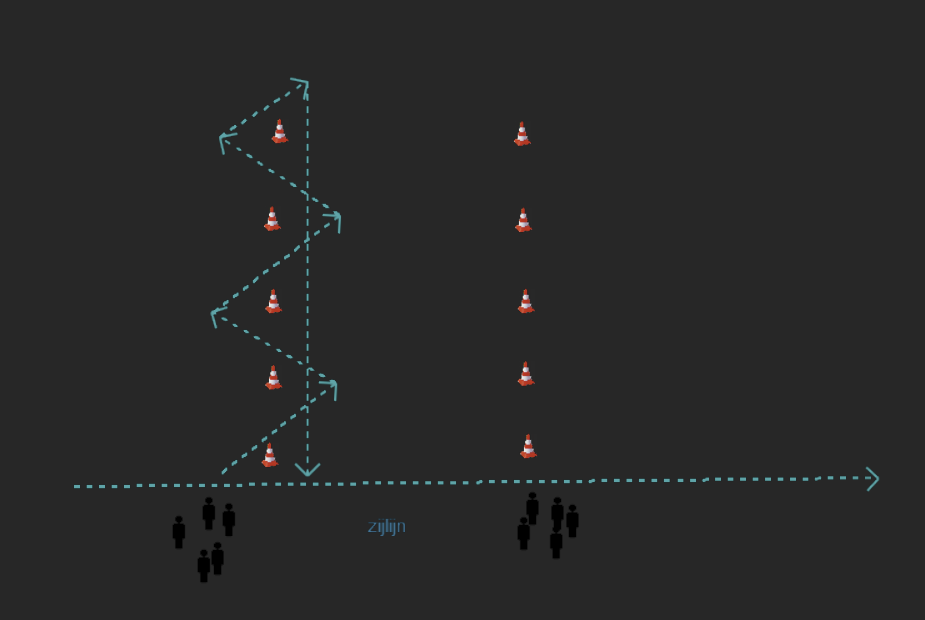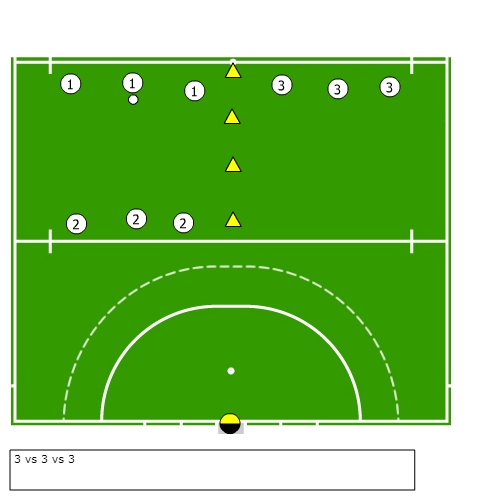Hockey drills

- A slalom exercise
- watch how the hands are holding the stick
- where they have the ball
- And if they use the stick properly when they run through the exercise!
- If it goes well, you can make a game of it and see if they master this. The team that has been through all the exercises first has won.
- Two players stand behind each other. Around them 4 pawns in an angle: 3 next to them/2 behind them
- The ball is passed to the player in front.
- She runs around the pawn in front, turns left and plays the second player between the pawns.
- The second player rebounds between the cones.
- This repeats itself, then the first player finishes on goal.
- Players divided into two groups on one side of the field.
- Two rows of cones next to each other.
- Players pass the ball back and forth while walking past the cones.
- Variations
- Individuals keep ball high along a row of cones, both groups independent of each other.
- Passing the ball two by two
- Individually dribble two balls at the same time, slalom through the cones
- Pass the ball and dribble a second ball at the same time (player says yes).
- Three of you play over 2 balls to the other side.
Goal
- To practise running through the ball in motion (accepting in the run).
Set up
- 2 players stand in a line (e.g. sideline)
- and 1 player stands 10-20 metres away.
- The first player of the team runs a few metres and then passes the ball to the second player.
- and passes the ball to the person standing alone.
- He starts running roughly at the time of the pass.
- This way, he runs through the ball at the moment he takes over.
- The person who passed then moves to the 1-ling position
- The exercise can be made more difficult by lengthening the distance between passes In addition, a passing move can be made before the pass.
Purpose
- Practicing different techniques. (Also useful to observe how things are going during the 1st training).
Set up
- All players line up on the baseline (or another line) and do a certain
- and do a certain exercise until the 23m line (or another line).
- This can be only floating, or floating + at whistle a drag or lift, etc.
- Important is that it is not about the fastest, but the best!
- You can make it easier or more difficult by making a difference in the exercise.
Goal
- To regain that ball feeling and get back into the swing of things.
Set up
- The players form pairs
- and they stand opposite each other on a few meters (5 for example).
- Then they start pushing each other.
- At a certain moment, they take some more distance and start flattening.
Goal
- The goal of this exercise is to learn to look ahead when floating. In addition, you train your ability to react.
Set up
- The players line up on, for example, the back line.
- The trainer stands 10-15 metres away from the players.
- At an agreed signal, the players start drifting towards an imaginary line at your height.
- But in the meantime, they have to look in front of them, because you raise a certain number of fingers and the players have to say that number.
- To make this exercise more difficult, you can ask the players to make a passing move on an agreed signal, or you can make the distance bigger, or the players have to walk instead of saying the number, to a point which corresponds with the number.
Play a 2-1 and try to score in the goal.
If the defender captures the ball, he passes it to the next duo.
Alternate the defender.
There is a square just outside the 23 in the middle.
3 teams between 4 and 6 players.
- Team A starts attacking from the right, trying to score;
- Pay attention to scoring positions (guard, spot, 2nd pole);
- If team A scores, the coach throws in a bonus ball
- If the ball goes out, it is for team B(defence)
- Team B's task is to play into team C's position;
- Team C then moves the ball to the right and starts attacking.
- Team A then goes to defend
- A plays the ball to the incoming B
- B rebounds the ball
- A drives a little
- B offers himself wide and A plays the ball into the space to B
- Because of B's running action outside, C makes space by running inside.
- B accelerates during his running action with the ball over the back line.
- C has gone towards the dot
- B passes, C rounds off (one-touch).
Variation: Exercise 2x.
Start with a three-run.
- A floats with the ball, when A is halfway, he pushes the ball out of the run to B.
- B does the same (to C)
- etc.
- Apply differentiation.
Possibly after this warm-up play another game of possession.
Goal
:To be able to quickly switch between offense and defense.
Format
:The field between the 23m line and the halfway line is divided into two parts. There are three teams of 3 players. Two teams play against each other, the remaining team has a break.
- Team 1 and 2 play against each other. Goal of team 1 is to score, goal of team 2 is to get the ball to team 3.
- When one team scores, the other team has to start the next game as defender. E.g. Team 1 scores against team 2, then team 2 plays as defensive team against team 3.
- When team 2 has taken possession of the ball, they play it to team 3. Team 3 starts attacking team 1 as soon as they receive the ball. Team 1 must then switch from attack to defence. Team two now takes the place of team 2 and awaits the play between 3 and 1.

Variations:
- The number of players per team can be adjusted.
- The field can be made narrower.
Points of attention:
- The game should continue as much as possible. To do this, it is useful to have a lot of balls with you as a coach so you can throw them into the exercise.








